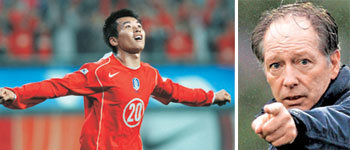Successful Players in Harmony with Coach
Successful Players in Harmony with Coach
Posted December. 22, 2004 22:46,

Injuries have been holding me back for a while, but, strangely I have not been injured under the new management.
The prince of the mens Korean National Soccer Team led by Johannes Bonfrere, Lee Dong-guk (25, Gwangju Sangmu) describes meeting Bonfrere as being better than winning the lotto. Eliminated from final consideration for the 2002 Korea-Japan World Cup, and letting alcohol ease his mind after that, Lee puts joining the army and meeting the national teams new management under Bonfrere as the major turning points to his stepping onto the field again.
On December 21, the 25-year-old, who played his last match in the FA Cup for Sangmu against Bucheon SK admitted, playing for Sangmu was a mental awakening, and playing under Bonfreres management bestowed me with confidence.
Lees Out-
Criticized by the public, and following Bonfreres assumption of the controls of the national team last June, Lee scored eight goals in 10 matches, and become the main option of attack. Also, improvements in his ankle injuries that have been chronic in his career suggest a well-harmonized chemistry between player and coach.
Korea is the first Asian country to appear five consecutive times in the World Cup finals and to accomplish the legend of the final four. Behind the success story of Korean soccer was the chemistry between managers and superstars.
Thirty-two years after the 1954 Swiss World Cup, Korea advanced to the 1986 Mexico World Cup finals. The first example of chemistry appeared between Kim Jung-nam (61), current manager of Ulsan Hyundai, and Heo Jung-moo (49), manager of the Jeonnam Dragons. At that time, I was already 30 years old and out of gas. But I played with all of my firepower to pay tribute to Kim, who brought me on as a starting striker for the team, said Heo.
The Korean team was unstable as they reorganized management five times before the Mexico World Cup regional qualifiers. However, after Kim took charge, Heo scored a decisive goal in the second match against Japan to clinch a ticket to the finals.
Guus Hiddink (58, Eindhoven), who led Korea to the final four of the 2002 Korea-Japan World Cup, seemed to react with Park Ji-sung (23, Eindhoven). The 20-year-old Park, unknown at the time, blossomed after meeting Hiddink, who took charge of Korean national soccer team in January 2001. He scored the final goal of the match against Portugal and helped Korea to advance to the elimination rounds.
Flat-footed and unfit, Park later confessed, I played my heart out to repay Hiddinks trust in me, even though I couldnt even feel my feet. Hiddink still trusts his precious, and keeps Park under his wing.
In a match against Spain in the 1990 Italy World Cup, Hwang Bo-gwan (39, Oita Trinita) scored an 114km/hr cannon-like goal to lift Lee Hoi-taeks (58, KFA) dignity, and supersonic Seo Jung-won (34, Suwon) who scored an equalizer against Spain in the 1994 US World Cup under Kim Ho (60), were good examples of chemistry between coach and player.
On the other hand, Choi Yong-soo (31, Kyoto Purple Sanga), who scored seven goals in the preliminary rounds of 1998 France World Cup to become the prince of Cha Bum-keuns (50, Suwon) campaign, was left out of the entry against Mexico in the finals. Unfortunately, Cha also faced two consecutive losses against Mexico and the Netherlands, suggesting a breakage of chemistry with players, resulting in his removal from management.
Soon-Il Kwon stt77@donga.com







